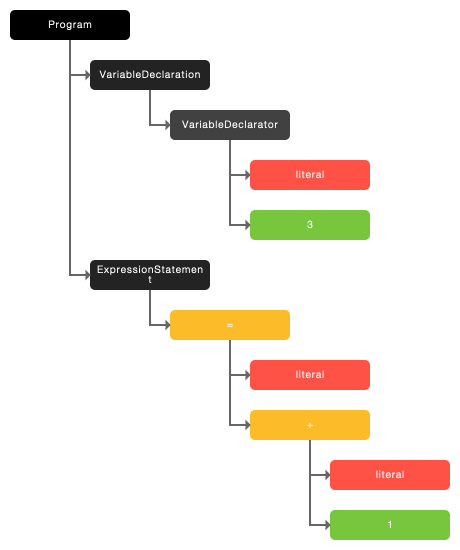I'm playing around with AST generation and exploring how it relates to a directed acyclic graph. I hit a logical snag that I don't understand.
var literal = 3; // expression 1
literal = literal+1; // expression 2
Clearly the value of literal is 4; that is, once expression 2 has been parsed.
No, it is not. It has the value 4 once the code is executed, but there is no such thing as a "value" during parsing. "Value" is a semantic thing, not a syntactic thing.
Logically, though, the actual result of expression 1 is dependent on expression 2, and expression 2 is dependent on expression 1.
That is true when evaluating, but not when parsing.
Can an acyclic graph represent the above?
Sure. Here is an example of what a hypothetical AST for a hypothetical language in which your code is valid might look like:

And, since your code happens to be valid ECMAScript source code, here are two not hypothetical examples of how a real ECMAScript parser would parse your code.
This first one was generated with JointJS:

And this one was generated with AST Explorer, which is based on the Acorn ECMAScript parser:
---
type: Program
body:
- type: VariableDeclaration
declarations:
- type: VariableDeclarator
id:
type: Identifier
name: literal
init:
type: Literal
value: 3
kind: var
- type: ExpressionStatement
expression:
type: AssignmentExpression
operator: "="
left:
type: Identifier
name: literal
right:
type: BinaryExpression
left:
type: Identifier
name: literal
operator: "+"
right:
type: Literal
value: 1
As you can see, none of these three require any cycles.
Obviously since ASTs are graphs, and an AST can parse the above without overflowing (i.e. cyclic) there must be some sort of temporal parameter that is part of the DAG that I'm missing.
There is nothing "temporal" in parsing. Syntax and grammar are completely static properties of a programming language. (Well, there are a very small number of mostly very obscure programming languages where the programmer can modify the syntax at runtime. Let's ignore these for now.)




literal = expression(literal)is a self-referential statement, i.e.literal = expression(literal = expression(literal = expression(literal = ...literalexists, but not yet resolve it. That typically happens in later phases, after parsing. Sometimes the AST is enriched with such info, sometimes there is a separate Intermediate Representation (IR). You may find the LLVM IR to be particularly interesting because all its virtual registers are assign-once, making data flow analysis straightforward. There might be different registers for each "version" of the variable. Can still be cyclic though, if you have loops.